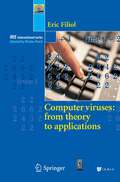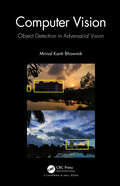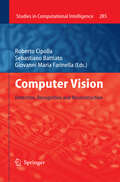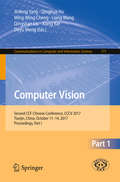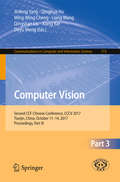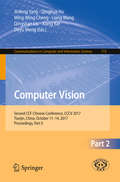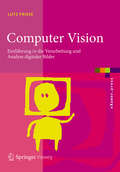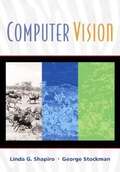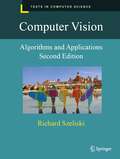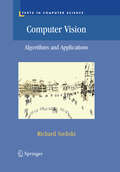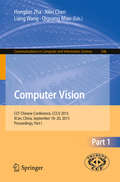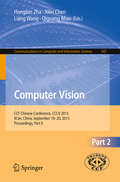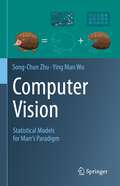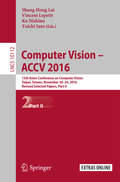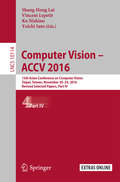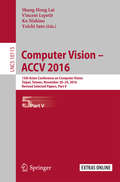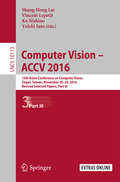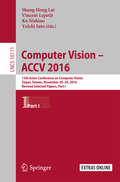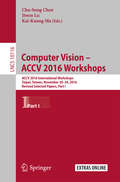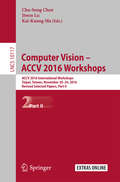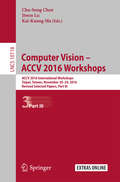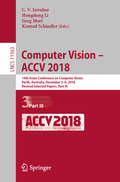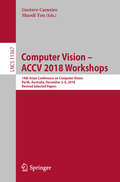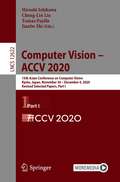- Table View
- List View
Computer Viruses: from theory to applications (Collection IRIS)
by Eric FiliolA precise and exhaustive description of different types of malware from three different points of view, namely the theoretical fundamentals of computer virology, algorithmic and practical aspects of viruses and their potential applications to various areas.
Computer Vision: Object Detection In Adversarial Vision
by Mrinal Kanti BhowmikThis comprehensive textbook presents a broad review of both traditional (i.e., conventional) and deep learning aspects of object detection in various adversarial real-world conditions in a clear, insightful, and highly comprehensive style. Beginning with the relation of computer vision and object detection, the text covers the various representation ofobjects, applications of object detection, and real-world challenges faced by the research community for object detection task. The book addresses various real-world degradations and artifacts for the object detection task and also highlights the impacts of artifacts in the object detection problems. The book covers various imaging modalities and benchmark datasets mostly adopted by the research community for solving various aspects of object detection tasks. The book also collects together solutions and perspectives proposed by the preeminent researchers in the field, addressing not only the background of visibility enhancement but also techniques proposed in the literature for visibility enhancement of scenes and detection of objects in various representative real-world challenges.Computer Vision: Object Detection in Adversarial Vision is unique for its diverse content, clear presentation, and overall completeness. It provides a clear, practical, and detailed introduction and advancement of object detection in various representative challenging real-world conditions.Topics and Features:• Offers the first truly comprehensive presentation of aspects of the object detection in degraded and nondegraded environment.• Includes in-depth discussion of various degradation and artifacts, and impact of those artifacts in the real world on solving the object detection problems.• Gives detailed visual examples of applications of object detection in the real world.• Presents a detailed description of popular imaging modalities for object detection adopted by researchers.• Presents the key characteristics of various benchmark datasets in indoor and outdoor environment for solving object detection tasks.• Surveys the complete field of visibility enhancement of degraded scenes, including conventional methods designed for enhancing the degraded scenes as well as the deep architectures. • Discusses techniques for detection of objects in real-world applications.• Contains various hands-on practical examples and a tutorial for solving object detection problems using Python.• Motivates readers to build vision-based systems for solving object detection problems in degraded and nondegraded real-world challenges.The book will be of great interest to a broad audience ranging from researchers and practitioners to graduate and postgraduate students involved in computer vision tasks with respect to object detection in degraded and nondegraded real-world vision problems.
Computer Vision: Object Detection In Adversarial Vision
by Mrinal Kanti BhowmikThis comprehensive textbook presents a broad review of both traditional (i.e., conventional) and deep learning aspects of object detection in various adversarial real-world conditions in a clear, insightful, and highly comprehensive style. Beginning with the relation of computer vision and object detection, the text covers the various representation ofobjects, applications of object detection, and real-world challenges faced by the research community for object detection task. The book addresses various real-world degradations and artifacts for the object detection task and also highlights the impacts of artifacts in the object detection problems. The book covers various imaging modalities and benchmark datasets mostly adopted by the research community for solving various aspects of object detection tasks. The book also collects together solutions and perspectives proposed by the preeminent researchers in the field, addressing not only the background of visibility enhancement but also techniques proposed in the literature for visibility enhancement of scenes and detection of objects in various representative real-world challenges.Computer Vision: Object Detection in Adversarial Vision is unique for its diverse content, clear presentation, and overall completeness. It provides a clear, practical, and detailed introduction and advancement of object detection in various representative challenging real-world conditions.Topics and Features:• Offers the first truly comprehensive presentation of aspects of the object detection in degraded and nondegraded environment.• Includes in-depth discussion of various degradation and artifacts, and impact of those artifacts in the real world on solving the object detection problems.• Gives detailed visual examples of applications of object detection in the real world.• Presents a detailed description of popular imaging modalities for object detection adopted by researchers.• Presents the key characteristics of various benchmark datasets in indoor and outdoor environment for solving object detection tasks.• Surveys the complete field of visibility enhancement of degraded scenes, including conventional methods designed for enhancing the degraded scenes as well as the deep architectures. • Discusses techniques for detection of objects in real-world applications.• Contains various hands-on practical examples and a tutorial for solving object detection problems using Python.• Motivates readers to build vision-based systems for solving object detection problems in degraded and nondegraded real-world challenges.The book will be of great interest to a broad audience ranging from researchers and practitioners to graduate and postgraduate students involved in computer vision tasks with respect to object detection in degraded and nondegraded real-world vision problems.
Computer Vision: Detection, Recognition and Reconstruction (Studies in Computational Intelligence #285)
by Roberto Cipolla Sebastiano Battiato Giovanni Maria FarinellaComputer vision is the science and technology of making machines that see. It is concerned with the theory, design and implementation of algorithms that can automatically process visual data to recognize objects, track and recover their shape and spatial layout. The International Computer Vision Summer School - ICVSS was established in 2007 to provide both an objective and clear overview and an in-depth analysis of the state-of-the-art research in Computer Vision. The courses are delivered by world renowned experts in the field, from both academia and industry, and cover both theoretical and practical aspects of real Computer Vision problems. The school is organized every year by University of Cambridge (Computer Vision and Robotics Group) and University of Catania (Image Processing Lab). Different topics are covered each year. A summary of the past Computer Vision Summer Schools can be found at: http://www.dmi.unict.it/icvss This edited volume contains a selection of articles covering some of the talks and tutorials held during the first two editions of the school on topics such as Recognition, Registration and Reconstruction. The chapters provide an in-depth overview of these challenging areas with key references to the existing literature.
Computer Vision: Second CCF Chinese Conference, CCCV 2017, Tianjin, China, October 11–14, 2017, Proceedings, Part I (Communications in Computer and Information Science #771)
by Jinfeng Yang, Qinghua Hu, Ming-Ming Cheng, Liang Wang, Qingshan Liu, Xiang Bai and Deyu MengThis three volume set, CCIS 771, 772, 773, constitutes the refereed proceedings of the CCF Chinese Conference on Computer Vision, CCCV 2017, held in Tianjin, China, in October 2017. The total of 174 revised full papers presented in three volumes were carefully reviewed and selected from 465 submissions. The papers are organized in the following topical sections: biological vision inspired visual method; biomedical image analysis; computer vision applications; deep neural network; face and posture analysis; image and video retrieval; image color and texture; image composition; image quality assessment and analysis; image restoration; image segmentation and classification; image-based modeling; object detection and classification; object identification; photography and video; robot vision; shape representation and matching; statistical methods and learning; video analysis and event recognition; visual salient detection.
Computer Vision: Second CCF Chinese Conference, CCCV 2017, Tianjin, China, October 11–14, 2017, Proceedings, Part III (Communications in Computer and Information Science #773)
by Jinfeng Yang, Qinghua Hu, Ming-Ming Cheng, Liang Wang, Qingshan Liu, Xiang Bai and Deyu MengThis three volume set, CCIS 771, 772, 773, constitutes the refereed proceedings of the CCF Chinese Conference on Computer Vision, CCCV 2017, held in Tianjin, China, in October 2017. The total of 174 revised full papers presented in three volumes were carefully reviewed and selected from 465 submissions. The papers are organized in the following topical sections: biological vision inspired visual method; biomedical image analysis; computer vision applications; deep neural network; face and posture analysis; image and video retrieval; image color and texture; image composition; image quality assessment and analysis; image restoration; image segmentation and classification; image-based modeling; object detection and classification; object identification; photography and video; robot vision; shape representation and matching; statistical methods and learning; video analysis and event recognition; visual salient detection.
Computer Vision: Second CCF Chinese Conference, CCCV 2017, Tianjin, China, October 11–14, 2017, Proceedings, Part II (Communications in Computer and Information Science #772)
by Jinfeng Yang, Qinghua Hu, Ming-Ming Cheng, Liang Wang, Qingshan Liu, Xiang Bai and Deyu MengThis three volume set, CCIS 771, 772, 773, constitutes the refereed proceedings of the CCF Chinese Conference on Computer Vision, CCCV 2017, held in Tianjin, China, in October 2017. The total of 174 revised full papers presented in three volumes were carefully reviewed and selected from 465 submissions. The papers are organized in the following topical sections: biological vision inspired visual method; biomedical image analysis; computer vision applications; deep neural network; face and posture analysis; image and video retrieval; image color and texture; image composition; image quality assessment and analysis; image restoration; image segmentation and classification; image-based modeling; object detection and classification; object identification; photography and video; robot vision; shape representation and matching; statistical methods and learning; video analysis and event recognition; visual salient detection
Computer Vision: Einführung in die Verarbeitung und Analyse digitaler Bilder (eXamen.press)
by Lutz PrieseDer Autor erläutert in dieser Einführung auf Bachelorniveau die in der Computer Vision verwendeten technischen Ausdrücke: Grundlagen des menschlichen Sehens, Farbe, exakte Begriffsbestimmungen zum Thema "Bild", Transformationen, lineare und nicht-lineare Filter, Fouriertransformation, Morphologie, Merkmale im Bild wie Kanten, Ecken, geometrische Formen mittels Hough-Transformation, diverse Hüllen und Skelettierung. Ferner höhere Merkmale wie SIFT, Shape-Context und statistische Merkmale, Texturmerkmale. Die Bestimmung von Segmenten (zusammenhängende Regionen ähnlicher Farben oder Grauwerte) wird in einem eigenen Kapitel ausführlich behandelt.
Computer Vision
by George Stockman Linda G. ShapiroUsing a progressive intuitive/mathematical approach, this introduction to computer vision provides necessary theory and examples for practitioners who work in fields where significant information must be extracted automatically from images-- including those interested in multimedia, art and design, geographic information systems, and image databases, in addition to the traditional areas of automation, image science, medical imaging, remote sensing and computer cartography. The book provides a basic set of fundamental concepts, (representations of image information, extraction of 3D scene information from 2D images, etc.) algorithms for analyzing images, and discusses some of the exciting evolving application areas of computer vision. The approach is language and software independent, and includes two significant commercial case studies. Imaging and Image Representation. Binary Image Analysis. Pattern Recognition Concepts. Filtering and Enhancing Images. Color and Shading. Texture. Content-Based Image Retrieval. Motion from 2D Image Sequences. Image Segmentation. Matching in 2D. Perceiving 3D from 2D Images. 3D Sensing and Object Pose Computation. 3D Models and Matching. Virtual Reality. Case Studies. For practitioners in any field where information must be extracted automatically from images.
Computer Vision: Algorithms and Applications (Texts in Computer Science)
by Richard SzeliskiComputer Vision: Algorithms and Applications explores the variety of techniques used to analyze and interpret images. It also describes challenging real-world applications where vision is being successfully used, both in specialized applications such as image search and autonomous navigation, as well as for fun, consumer-level tasks that students can apply to their own personal photos and videos.More than just a source of “recipes,” this exceptionally authoritative and comprehensive textbook/reference takes a scientific approach to the formulation of computer vision problems. These problems are then analyzed using the latest classical and deep learning models and solved using rigorous engineering principles.Topics and features:Structured to support active curricula and project-oriented courses, with tips in the Introduction for using the book in a variety of customized coursesIncorporates totally new material on deep learning and applications such as mobile computational photography, autonomous navigation, and augmented realityPresents exercises at the end of each chapter with a heavy emphasis on testing algorithms and containing numerous suggestions for small mid-term projectsIncludes 1,500 new citations and 200 new figures that cover the tremendous developments from the last decadeProvides additional material and more detailed mathematical topics in the Appendices, which cover linear algebra, numerical techniques, estimation theory, datasets, and softwareSuitable for an upper-level undergraduate or graduate-level course in computer science or engineering, this textbook focuses on basic techniques that work under real-world conditions and encourages students to push their creative boundaries. Its design and exposition also make it eminently suitable as a unique reference to the fundamental techniques and current research literature in computer vision.
Computer Vision: Algorithms and Applications (Texts in Computer Science)
by Richard SzeliskiComputer Vision: Algorithms and Applications explores the variety of techniques commonly used to analyze and interpret images. It also describes challenging real-world applications where vision is being successfully used, both for specialized applications such as medical imaging, and for fun, consumer-level tasks such as image editing and stitching, which students can apply to their own personal photos and videos. More than just a source of “recipes,” this exceptionally authoritative and comprehensive textbook/reference also takes a scientific approach to basic vision problems, formulating physical models of the imaging process before inverting them to produce descriptions of a scene. These problems are also analyzed using statistical models and solved using rigorous engineering techniques. Topics and features: structured to support active curricula and project-oriented courses, with tips in the Introduction for using the book in a variety of customized courses; presents exercises at the end of each chapter with a heavy emphasis on testing algorithms and containing numerous suggestions for small mid-term projects; provides additional material and more detailed mathematical topics in the Appendices, which cover linear algebra, numerical techniques, and Bayesian estimation theory; suggests additional reading at the end of each chapter, including the latest research in each sub-field, in addition to a full Bibliography at the end of the book; supplies supplementary course material for students at the associated website, http://szeliski.org/Book/. Suitable for an upper-level undergraduate or graduate-level course in computer science or engineering, this textbook focuses on basic techniques that work under real-world conditions and encourages students to push their creative boundaries. Its design and exposition also make it eminently suitable as a unique reference to the fundamental techniques and current research literature in computer vision.
Computer Vision: CCF Chinese Conference, CCCV 2015, Xi'an, China, September 18-20, 2015, Proceedings, Part I (Communications in Computer and Information Science #546)
by Hongbin Zha Xilin Chen Liang Wang Qiguang MiaoThe two volumes CCIS 546 and 547 constitute the refereed proceedings of the CCF Chinese Conference on Computer Vision, CCCV 2015, held in Xi'an, China, in September 2015. The total of 89 revised full papers presented in both volumes were carefully reviewed and selected from 176 submissions. The papers address issues such as computer vision, machine learning, pattern recognition, target recognition, object detection, target tracking, image segmentation, image restoration, face recognition, image classification.
Computer Vision: CCF Chinese Conference, CCCV 2015, Xi'an, China, September 18-20, 2015, Proceedings, Part II (Communications in Computer and Information Science #547)
by Hongbin Zha Xilin Chen Liang Wang Qiguang MiaoThe two volumes CCIS 546 and 547 constitute the refereed proceedings of the CCF Chinese Conference on Computer Vision, CCCV 2015, held in Xi'an, China, in September 2015. The total of 89 revised full papers presented in both volumes were carefully reviewed and selected from 176 submissions. The papers address issues such as computer vision, machine learning, pattern recognition, target recognition, object detection, target tracking, image segmentation, image restoration, face recognition, image classification.
Computer Vision: Statistical Models for Marr's Paradigm
by Song-Chun Zhu Ying Nian WuAs the first book of a three-part series, this book is offered as a tribute to pioneers in vision, such as Béla Julesz, David Marr, King-Sun Fu, Ulf Grenander, and David Mumford. The authors hope to provide foundation and, perhaps more importantly, further inspiration for continued research in vision. This book covers David Marr's paradigm and various underlying statistical models for vision. The mathematical framework herein integrates three regimes of models (low-, mid-, and high-entropy regimes) and provides foundation for research in visual coding, recognition, and cognition. Concepts are first explained for understanding and then supported by findings in psychology and neuroscience, after which they are established by statistical models and associated learning and inference algorithms. A reader will gain a unified, cross-disciplinary view of research in vision and will accrue knowledge spanning from psychology to neuroscience to statistics.
Computer Vision – ACCV 2016: 13th Asian Conference on Computer Vision, Taipei, Taiwan, November 20-24, 2016, Revised Selected Papers, Part II (Lecture Notes in Computer Science #10112)
by Shang-Hong Lai Vincent Lepetit Ko Nishino Yoichi SatoThe five-volume set LNCS 10111-10115 constitutes the thoroughly refereed post-conference proceedings of the 13th Asian Conference on Computer Vision, ACCV 2016, held in Taipei, Taiwan, in November 2016.The total of 143 contributions presented in these volumes was carefully reviewed and selected from 479 submissions. The papers are organized in topical sections on Segmentation and Classification; Segmentation and Semantic Segmentation; Dictionary Learning, Retrieval, and Clustering; Deep Learning; People Tracking and Action Recognition; People and Actions; Faces; Computational Photography; Face and Gestures; Image Alignment; Computational Photography and Image Processing; Language and Video; 3D Computer Vision; Image Attributes, Language, and Recognition; Video Understanding; and 3D Vision.
Computer Vision – ACCV 2016: 13th Asian Conference on Computer Vision, Taipei, Taiwan, November 20-24, 2016, Revised Selected Papers, Part IV (Lecture Notes in Computer Science #10114)
by Shang-Hong Lai Vincent Lepetit Ko Nishino Yoichi SatoThe five-volume set LNCS 10111-10115 constitutes the thoroughly refereed post-conference proceedings of the 13th Asian Conference on Computer Vision, ACCV 2016, held in Taipei, Taiwan, in November 2016.The total of 143 contributions presented in these volumes was carefully reviewed and selected from 479 submissions. The papers are organized in topical sections on Segmentation and Classification; Segmentation and Semantic Segmentation; Dictionary Learning, Retrieval, and Clustering; Deep Learning; People Tracking and Action Recognition; People and Actions; Faces; Computational Photography; Face and Gestures; Image Alignment; Computational Photography and Image Processing; Language and Video; 3D Computer Vision; Image Attributes, Language, and Recognition; Video Understanding; and 3D Vision.
Computer Vision – ACCV 2016: 13th Asian Conference on Computer Vision, Taipei, Taiwan, November 20-24, 2016, Revised Selected Papers, Part V (Lecture Notes in Computer Science #10115)
by Shang-Hong Lai Vincent Lepetit Ko Nishino Yoichi SatoThe five-volume set LNCS 10111-10115 constitutes the thoroughly refereed post-conference proceedings of the 13th Asian Conference on Computer Vision, ACCV 2016, held in Taipei, Taiwan, in November 2016.The total of 143 contributions presented in these volumes was carefully reviewed and selected from 479 submissions. The papers are organized in topical sections on Segmentation and Classification; Segmentation and Semantic Segmentation; Dictionary Learning, Retrieval, and Clustering; Deep Learning; People Tracking and Action Recognition; People and Actions; Faces; Computational Photography; Face and Gestures; Image Alignment; Computational Photography and Image Processing; Language and Video; 3D Computer Vision; Image Attributes, Language, and Recognition; Video Understanding; and 3D Vision.
Computer Vision – ACCV 2016: 13th Asian Conference on Computer Vision, Taipei, Taiwan, November 20-24, 2016, Revised Selected Papers, Part III (Lecture Notes in Computer Science #10113)
by Shang-Hong Lai, Vincent Lepetit, Ko Nishino and Yoichi SatoThe five-volume set LNCS 10111-10115 constitutes the thoroughly refereed post-conference proceedings of the 13th Asian Conference on Computer Vision, ACCV 2016, held in Taipei, Taiwan, in November 2016.The total of 143 contributions presented in these volumes was carefully reviewed and selected from 479 submissions. The papers are organized in topical sections on Segmentation and Classification; Segmentation and Semantic Segmentation; Dictionary Learning, Retrieval, and Clustering; Deep Learning; People Tracking and Action Recognition; People and Actions; Faces; Computational Photography; Face and Gestures; Image Alignment; Computational Photography and Image Processing; Language and Video; 3D Computer Vision; Image Attributes, Language, and Recognition; Video Understanding; and 3D Vision.
Computer Vision – ACCV 2016: 13th Asian Conference on Computer Vision, Taipei, Taiwan, November 20-24, 2016, Revised Selected Papers, Part I (Lecture Notes in Computer Science #10111)
by Shang-Hong Lai, Vincent Lepetit, Ko Nishino and Yoichi SatoThe five-volume set LNCS 10111-10115 constitutes the thoroughly refereed post-conference proceedings of the 13th Asian Conference on Computer Vision, ACCV 2016, held in Taipei, Taiwan, in November 2016. The total of 143 contributions presented in these volumes was carefully reviewed and selected from 479 submissions. The papers are organized in topical sections on Segmentation and Classification; Segmentation and Semantic Segmentation; Dictionary Learning, Retrieval, and Clustering; Deep Learning; People Tracking and Action Recognition; People and Actions; Faces; Computational Photography; Face and Gestures; Image Alignment; Computational Photography and Image Processing; Language and Video; 3D Computer Vision; Image Attributes, Language, and Recognition; Video Understanding; and 3D Vision.
Computer Vision – ACCV 2016 Workshops: ACCV 2016 International Workshops, Taipei, Taiwan, November 20-24, 2016, Revised Selected Papers, Part I (Lecture Notes in Computer Science #10116)
by Chu-Song Chen Jiwen Lu Kai-Kuang MaThe three-volume set, consisting of LNCS 10116, 10117, and 10118, contains carefully reviewed and selected papers presented at 17 workshops held in conjunction with the 13th Asian Conference on Computer Vision, ACCV 2016, in Taipei, Taiwan in November 2016. The 134 full papers presented were selected from 223 submissions. LNCS 10116 contains the papers selected
Computer Vision – ACCV 2016 Workshops: ACCV 2016 International Workshops, Taipei, Taiwan, November 20-24, 2016, Revised Selected Papers, Part II (Lecture Notes in Computer Science #10117)
by Chu-Song Chen Jiwen Lu Kai-Kuang MaThe three-volume set, consisting of LNCS 10116, 10117, and 10118, contains carefully reviewed and selected papers presented at 17 workshops held in conjunction with the 13th Asian Conference on Computer Vision, ACCV 2016, in Taipei, Taiwan in November 2016. The 134 full papers presented were selected from 223 submissions. LNCS 10116 contains the papers selected
Computer Vision – ACCV 2016 Workshops: ACCV 2016 International Workshops, Taipei, Taiwan, November 20-24, 2016, Revised Selected Papers, Part III (Lecture Notes in Computer Science #10118)
by Chu-Song Chen Jiwen Lu Kai-Kuang MaThe three-volume set, consisting of LNCS 10116, 10117, and 10118, contains carefully reviewed and selected papers presented at 17 workshops held in conjunction with the 13th Asian Conference on Computer Vision, ACCV 2016, in Taipei, Taiwan in November 2016. The 134 full papers presented were selected from 223 submissions. LNCS 10116 contains the papers selected
Computer Vision – ACCV 2018: 14th Asian Conference on Computer Vision, Perth, Australia, December 2–6, 2018, Revised Selected Papers, Part III (Lecture Notes in Computer Science #11363)
by C. V. Jawahar Hongdong Li Greg Mori Konrad SchindlerThe six volume set LNCS 11361-11366 constitutes the proceedings of the 14th Asian Conference on Computer Vision, ACCV 2018, held in Perth, Australia, in December 2018. The total of 274 contributions was carefully reviewed and selected from 979 submissions during two rounds of reviewing and improvement. The papers focus on motion and tracking, segmentation and grouping, image-based modeling, dep learning, object recognition object recognition, object detection and categorization, vision and language, video analysis and event recognition, face and gesture analysis, statistical methods and learning, performance evaluation, medical image analysis, document analysis, optimization methods, RGBD and depth camera processing, robotic vision, applications of computer vision.
Computer Vision – ACCV 2018 Workshops: 14th Asian Conference on Computer Vision, Perth, Australia, December 2–6, 2018, Revised Selected Papers (Lecture Notes in Computer Science #11367)
by Gustavo Carneiro Shaodi YouThis LNCS workshop proceedings, ACCV 2018, contains carefully reviewed and selected papers from 11 workshops, each having different types or programs: Scene Understanding and Modelling (SUMO) Challenge, Learning and Inference Methods for High Performance Imaging (LIMHPI), Attention/Intention Understanding (AIU), Museum Exhibit Identification Challenge (Open MIC) for Domain Adaptation and Few-Shot Learning, RGB-D - Sensing and Understanding via Combined Colour and Depth, Dense 3D Reconstruction for Dynamic Scenes, AI Aesthetics in Art and Media (AIAM), Robust Reading (IWRR), Artificial Intelligence for Retinal Image Analysis (AIRIA), Combining Vision and Language, Advanced Machine Vision for Real-life and Industrially Relevant Applications (AMV).
Computer Vision – ACCV 2020: 15th Asian Conference on Computer Vision, Kyoto, Japan, November 30 – December 4, 2020, Revised Selected Papers, Part I (Lecture Notes in Computer Science #12622)
by Hiroshi Ishikawa Cheng-Lin Liu Tomas Pajdla Jianbo ShiThe six volume set of LNCS 12622-12627 constitutes the proceedings of the 15th Asian Conference on Computer Vision, ACCV 2020, held in Kyoto, Japan, in November/ December 2020.*The total of 254 contributions was carefully reviewed and selected from 768 submissions during two rounds of reviewing and improvement. The papers focus on the following topics: Part I: 3D computer vision; segmentation and grouping Part II: low-level vision, image processing; motion and tracking Part III: recognition and detection; optimization, statistical methods, and learning; robot vision Part IV: deep learning for computer vision, generative models for computer vision Part V: face, pose, action, and gesture; video analysis and event recognition; biomedical image analysis Part VI: applications of computer vision; vision for X; datasets and performance analysis *The conference was held virtually.
